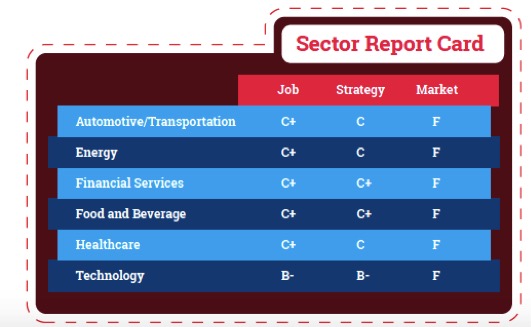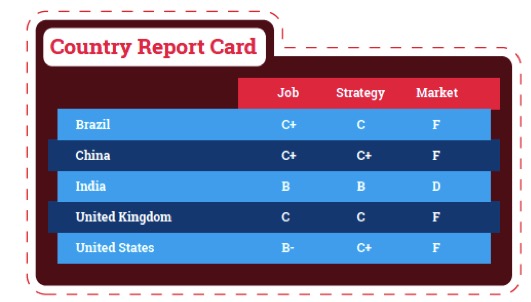This is an IPR Signature Study conducted by the IPR Commission on Organizational Communication and a part of the Organizational Communication Research Center.
Thanks to our sponsors for their generous support:

Download Full White Paper (PDF): Organizational Clarity: The Case for Workforce Alignment and Belief
Download Infographic (PDF): Organizational Clarity: The Case for Workforce Alignment and Belief
Executive Summary
The Institute for Public Relations (IPR) Commission on Organizational Communication has released the first global study on Organizational Clarity, finding organizations are failing to provide a clear “line-of-sight” to employees. “Organizational Clarity: The Case for Workforce Alignment and Belief,” shows that 1,500 employees in five countries are confident they understand the core purpose of their organization and find meaning in their work, but believe organizations have much work to be done in prioritizing and communicating strategy internally. In companies throughout the world, employees are inundated with information and rely on organizational behavior and action to connect the dots for them on vision, strategy and direction. In addition to the research findings, the study also offers takeaways and suggested actions to improve Organizational Clarity and drive performance.
Method
More than 1,500 employees in five countries— United States, United Kingdom, India, Brazil and China—were surveyed about how well they think their organization connects to three dimensions in terms of employee alignment: JOB, STRATEGY, and MARKET. Each country received a grade ranging from “A” to “F,” based on the mean responses from their employees.
Model of Organizational Clarity
While the concept of Organizational Clarity is new, it is distilled from a broad range of research disciplines – including organizational studies, economics, sociology, psychology, and management studies. Based on the review of the literature, there are three key dimensions to Organizational Clarity needed to model and measure success:
- The JOB dimension explores to what degree an employee looks inside his or her organization to understand the organization’s strategy, and how the strategy is applicable within their job. In the JOB dimension, employees should have a clear understanding of the organization’s core purpose, and find that their job and contributions have an impact on their organization’s success. In other words, does the employee understand strategy through the lens of his/her job?
- The STRATEGY dimension explores to what degree an employee looks inside their organization to understand their organization’s strategy, but also looks outside the organization to ‘reality check’ the strategy against their own perceptions of the marketplace. In the STRATEGY dimension, an employee believes the organization knows what it is doing, and that the organization’s strategy will be successful in the future. Additionally, the employee is confident in the organization’s ability to be strategic. Also, the employee trusts in the organization’s ability to execute the strategy while verifying their knowledge of the marketplace.
- The MARKET dimension explores whether an employee looks solely outside of their organization to understand their future employment prospects. In other words, does the employee look first to the marketplace to understand his/her future? In the MARKET dimension, an employee feels a connection to their profession more than their current organization and finds their current job as a stepping stone to their next job. Also, the employee thinks that their organization reacts more often to the market than shapes it.
 Building on these three key dimensions, a model was constructed where Organizational Clarity is increased when employees understand the marketplace as seen through the lens of the company’s strategy. Organizational Clarity can be increased both by the JOB dimension and the STRATEGY dimension. This is referred to as a “clockwise” organization, and one which is expected to outperform its sector. By contrast, Organizational Clarity is decreased when employees understand their marketplace with little or no reference to their company’s strategy. The MARKET dimension is the only dimension that decreases Organizational Clarity. This is referred to as an “anti-clockwise” organization, and one which is expected to underperform its sector.
Building on these three key dimensions, a model was constructed where Organizational Clarity is increased when employees understand the marketplace as seen through the lens of the company’s strategy. Organizational Clarity can be increased both by the JOB dimension and the STRATEGY dimension. This is referred to as a “clockwise” organization, and one which is expected to outperform its sector. By contrast, Organizational Clarity is decreased when employees understand their marketplace with little or no reference to their company’s strategy. The MARKET dimension is the only dimension that decreases Organizational Clarity. This is referred to as an “anti-clockwise” organization, and one which is expected to underperform its sector.
Key Findings
The best to worst performing countries in terms of Organizational Clarity were India, United States, China, Brazil and the United Kingdom. Some key findings include:
 Grades on the JOB dimension ranged from a “B” for India to a “C” for the U.K. Most employees gave high marks to their understanding of the organization’s core purpose, and said they found meaning in their jobs. Employees in the U.K. were less likely than their counterparts to say they were rewarded fairly.
Grades on the JOB dimension ranged from a “B” for India to a “C” for the U.K. Most employees gave high marks to their understanding of the organization’s core purpose, and said they found meaning in their jobs. Employees in the U.K. were less likely than their counterparts to say they were rewarded fairly.- India fared better than other countries, earning a “B” in the STRATEGY dimension as the U.K. scored the lowest with a “C.” Employees in the U.S. and India were more confident in their organization’s strategy over the next three years than those in other countries. Except for India, employees said organizations need to better use technology to communicate strategy, and to ensure that when initiatives are completed, the results get reported to employees.
- All countries earned “Fs” for MARKET, except for India that scored a D. Employees in the U.S. and the U.K. said too many initiatives in their organization are going on at the same time, their work priorities often conflict, and that they felt more connected to the profession than their organization.
IPR also investigated Organizational Clarity across six economic sectors–Automotive/Transportation, Energy, Financial Services, Food/Beverage, Healthcare, and Technology. Statistical differences within the three dimensions of the sectors were not found. Some key findings include:

- On the JOB dimension, grades ranged from “B-“ to “C+” as more than one out of four respondents said they were not rewarded fairly for their job.
- Grades across sectors in the STRATEGY dimensions ranged from a “B-“ to a “C,” with the technology sector leading the way thanks in part to employees reporting their companies communicated results better using technology than those in the other sectors.
- All sectors earned “Fs” in the MARKET dimension as organizations need to do a better job communicating their actions, and ensure employees do not feel their work priorities conflict.
Download Full White Paper: Organizational Clarity: The Case for Workforce Alignment and Belief

 Grades on the JOB dimension ranged from a “B” for India to a “C” for the U.K. Most employees gave high marks to their understanding of the organization’s core purpose, and said they found meaning in their jobs. Employees in the U.K. were less likely than their counterparts to say they were rewarded fairly.
Grades on the JOB dimension ranged from a “B” for India to a “C” for the U.K. Most employees gave high marks to their understanding of the organization’s core purpose, and said they found meaning in their jobs. Employees in the U.K. were less likely than their counterparts to say they were rewarded fairly.


